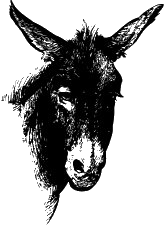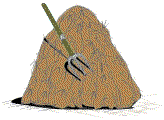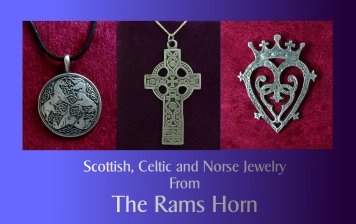HOME | home
Donkeys | Donkey Lore | Donkeys at Thistledown | John, the Farrier Comes | Morgan Horses | Horse Health | Horse Thieves | Driving Horses
Donkey Lore
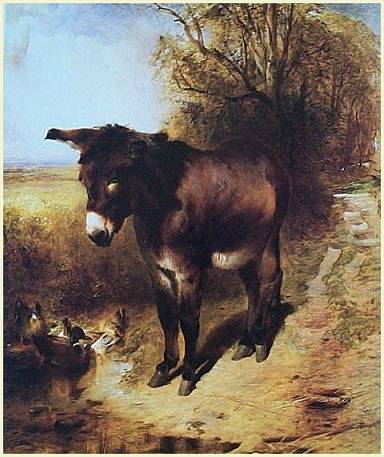
In the Long service of Mankind
Donkeys in Ireland
 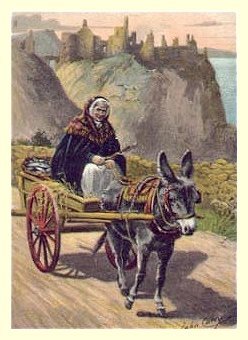 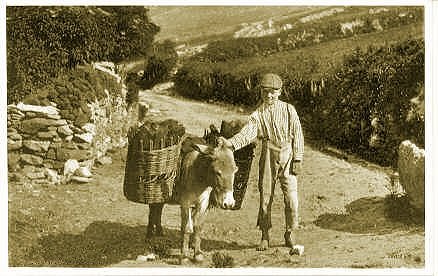 The Donkey was the lawn tractor/wheel barrow in old Ireland. There are still some today being used to haul the Turf or Peat. The Irish still burn Turf in their fire places. It is a fuel like coal.
You can find working donkeys, mostly in the West of Ireland but not like in the old days when roads were very poor and so were many of the people. Donkeys make the perfect work mates as they walk at about the same pace as people and tend to be able to do more work for their size than any other beast of burden except mules. Donkeys are thrifty and don't need the high protein a horse or pony requires. They are patient and long suffering to boot. Often donkeys will work without even a halter or bridle and will stay with their masters all day working willingly.
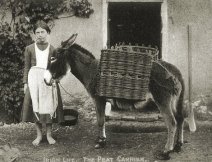 Having a wheelbarrow you don't have to push that can go through water and over bumpy ground is something that is still useful today. For people who ask me why we care so much for donkeys we say "Having a horse's body and a dog's brain makes for the perfect companion. " Donkeys come in many sizes so you can find one that fits your lifestyle. We have never been hurt by a donkey nor kicked. We have owned ten different individuals and even the shy ones who were somewhat fearful never caused anyone harm.
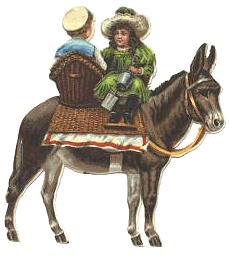 May the frost never afflict
your spuds,
may the outside leaves of your cabbage always be
free of worms,
may the crows never pick your haystack,
and may your donkey always be in foal
-olde Irish Proverb
Christian tradition hold that donkeys originally had unmarked hides, and that it was only after Christ's entry into Jerusalem on the back of a donkey that they recieved the dark cross on their backs. The hairs from the cross were widely believed to cure a number of ailments, and were often worn in a charm around the neck to guard against whooping-cough, toothache, fits, and to ease teething pains in babies. Riding a donkey was also believed effacious, especially if the rider faced the donkey's tail end, and was sometimes used as a preventative for toothache, measles and other children's complaints. One cure for whooping-cough and ague stated that the patient should be passed under a donkey and over its back either three or nine times; the trick of feeding an animal some of the patient's hair to transfer the illness was also used with donkeys. The donkey was also used to help cure the complaints of other animals; letting a black donkey run with mares in a field was thought to stop the mares miscarrying.
An old saying claims that no-one ever sees a dead donkey; however, there is also a tradition that to see a dead donkey means great good fortune, and even as recently as this century it was considered a good-luck charm to leap over the carcass of a dead donkey three times.
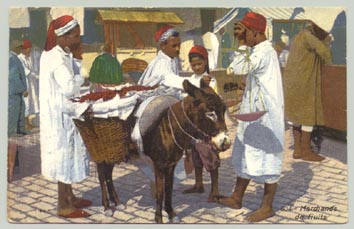 Donkeys were kept in great herds in ancient Egypt. In the tombs of the Dynasty IV (ca. 2675-2565 BC) are indications that wealthy and powerful people possessed droves of over a thousand head. In addition to their use as a pack animal, donkeys were employed to tread seeds into the fertile Nile floodplain and to thresh the harvest. Elsewhere, mares were kept as dairy animals. Donkey's milk, higher both in sugar and protein content than cow's milk, was used as food, as medicine, and as a cosmetic to promote a white skin. Donkey meat has also provided food for various people.
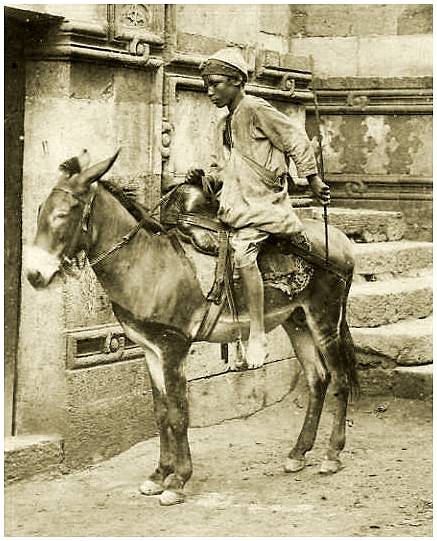 The Legend of the Donkey's Bray
After hiding in Egypt for some years, Joseph decided to move his family back to Nazareth. During the night they camped along the side of the road. One night while they slept, their donkey heard the soldiers' horses coming from afar. Afraid that the soldiers were coming to kill Jesus, the donkey neighed to wake Joseph. He neighed and neighed, again and again, but his voice was just too soft to wake the sleepers. Finally, as the soldiers approached, the donkey prayed for a loud voice to wake the family. When he neighed again, he was rewarded with the loud bray such as donkeys have had ever since.
Saint Nicholas and the Donkey
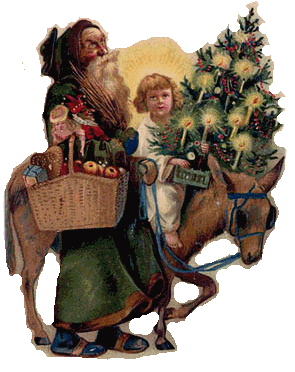 The earliest St. Nicholas was very tall and slender. It wasn’t until the tradition was brought to America that he put on all those extra pounds.
He also dressed much different than today. Only the flowing white beard and the color of his clothing bear any resemblance to our modern Santa.
Originally he wore the traditional clothing of a bishop. The red outfit came complete with a double pointed miter hat. Before the sleigh and eight tiny reindeer he made his rounds on the back of a donkey.
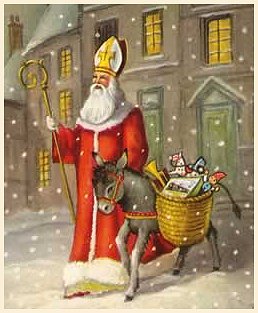 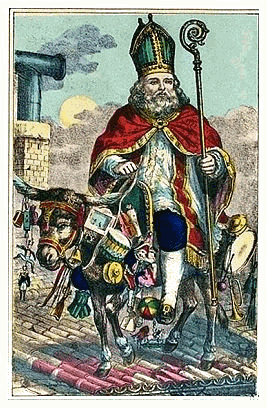 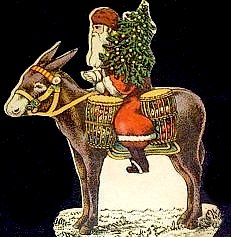 The donkey first appeared as a symbol for the Democratic Party in the 1830s when the Democrat Andrew Jackson was President. The donkey continued in American political commentary as a symbol for the Democratic Party thereafter. Thomas Nast built upon this legacy and used his extraordinary skill to amplify it. For a time, the rooster also served as the symbol of the Democratic Party, but gradually the donkey replaced it in popular usage after the 1880s.
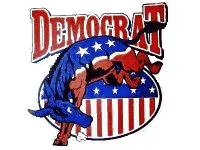 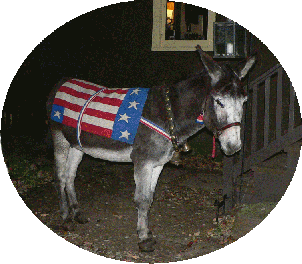 Donkey Bray
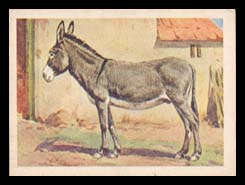 "If a donkey brays in the morning,
Let the haymakers take a warning;
If the donkey brays late at night,
Let the haymakers take delight."
-Welsh Folksaying
THE PET DONKEY
Sioux
Native American Lore
There was a chief's daughter once who had a great many relations so that everybody knew she belonged to a great family.
When she grew up she married and there were born to her twin sons. This caused great rejoicing in her father's camp, and all the village women came to see the babes. She was very happy.
As the babes grew older, their grandmother made for them two saddle bags and brought out a donkey.
"My two grandchildren," said the old lady, "shall ride as is becoming to children having so many relations. Here is this donkey. He is patient and surefooted. He shall carry the babes in the saddle bags, one on either side of his back."
It happened one day that the chief's daughter and her husband were making ready to go on a camping journey. The father, who was quite proud of his children, brought out his finest pony, and put the saddle bags on the pony's back.
"There," he said, "my sons shall ride on the pony, not on a donkey; let the donkey carry the pots and kettles."
So his wife loaded the donkey with the house-hold things. She tied the tepee poles into two great bundles, one on either side of the donkey's back; across them she put the travois net and threw into it the pots and kettles and laid the skin tent across the donkey's back.
But no sooner done than the donkey began to rear and bray and kick. He broke the tent poles and kicked the pots and kettles into bits and tore the skin tent. The more he was beaten the more he kicked.
At last they told the grandmother. She laughed. "Did I not tell you the donkey was for the children," she cried. "He knows the babies are the chief's children. Think you he will be dishonored with pots and kettles?" and she fetched the children and slung them over the donkey's back, when he became at once quiet again.
The camping party left the village and went on their journey. But the next day as they passed by a place overgrown with bushes, a band of enemies rushed out, lashing their ponies and sounding their war whoop. All was excitement. The men bent their bows and seized their lances. After a long battle the enemy fled. But when the camping party came together again -- where were the donkey and the two babes? No one knew. For a long time they searched, but in vain. At last they turned to go back to the village, the father mournful, the mother wailing. When they came to the grandmother's tepee, there stood the good donkey with the two babes in the saddle bags.
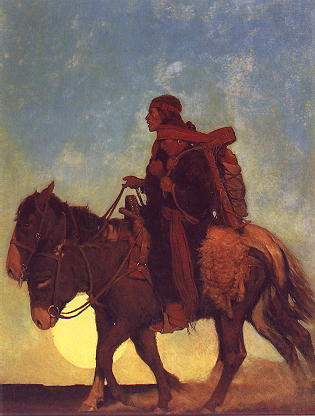 The Sunday before Easter, known as Palm Sunday. Jesus arrived in Jerusalem for the Jewish festival of Passover. Great crowds of people lined the streets waving palm branches to welcome Him. The people were very excited and they spread branches on the road. Some even laid down their robes. They shouted 'Hosanna!' Jesus rode into the city on the back of an colt ass, a young donkey. He did this to fulfill the scriptures. The legend has been handed down that the donkey before this time was a solid color but after Christ died on the cross on Good Friday all donkey's recieved the mark of the cross on their back as a reminder of the service of that donkey to our Lord on Palm Sunday.
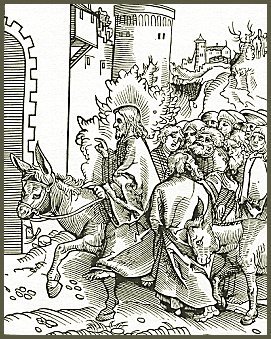 Matthew 21.1-11 NEB
Jesus and his disciples were nearing Jerusalem; and when they reached Bethphage at the Mount of Olives, Jesus sent two of them with these instructions: 'Go into the village opposite, where you will at once find a donkey tethered with her foal beside her; untie them, and bring them to me. If anyone speaks to you, say, "Our Master needs them"; and he will let you take them at once.' This was to fulfil the prophecy, which says, 'Tell the daughter of Zion, "Here is your king, who comes to you in gentleness, riding on an ass, riding on the foal of a beast of burden."'
The disciples went and did as Jesus had directed, and brought the donkey and her foal; they laid their cloaks on them and Jesus mounted. Crowds of people carpeted the road with their cloaks, and some cut branches from the trees to spread in his path. Then the crowd that went ahead and the others that came behind raised the shout: 'Hosanna to the Son of David! Blessings on him who comes in the name of the Lord! Hosanna in the heavens!'
When he entered Jerusalem the whole city went wild with excitement. 'Who is this?' people asked, and the crowd replied, 'This is the prophet Jesus, from Nazareth in Galilee.'
LINKS
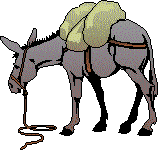 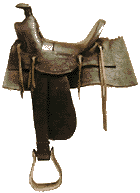 Celebrating its 41st Anniversary in 2008
The American Donkey and Mule Society,
PO Box 1210, Lewisville TX 75067
For more information about the ADMS,
call (972) 219-0781, Fax: (972) 420-9980
or e-mail them at adms@juno.
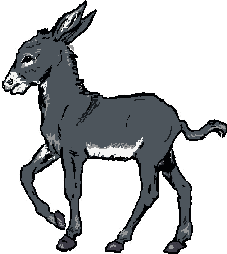  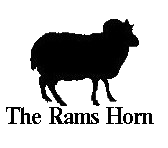 copyright 2002 , Jim & Beth Boyle, All Rights Reserved
No part of this website may be used for any purpose ( including using images )
without written consent from The Rams Horn
|
.................................................................................................................................................................................................................................................................................................................................
